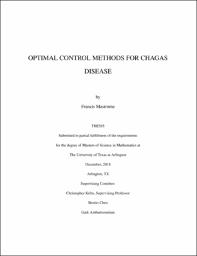
ATTENTION: The works hosted here are being migrated to a new repository that will consolidate resources, improve discoverability, and better show UTA's research impact on the global community. We will update authors as the migration progresses. Please see MavMatrix for more information.
Show simple item record
| dc.contributor.advisor | Kribs, Christopher | |
| dc.creator | Mastrome, Francis | |
| dc.date.accessioned | 2019-02-26T22:04:12Z | |
| dc.date.available | 2019-02-26T22:04:12Z | |
| dc.date.created | 2018-12 | |
| dc.date.issued | 2018-12-10 | |
| dc.date.submitted | December 2018 | |
| dc.identifier.uri | http://hdl.handle.net/10106/27776 | |
| dc.description.abstract | Chagas disease is the world's most neglected tropical disease. Having a lack of cure makes the primary focus on the disease preventing it and controlling it. This study takes into account three different control measures: bed nets, low-volume insecticide spraying, and improving housing conditions, analyzes their cost effectiveness compared to each other, and determines which combination of the three control measures prevents the most T. cruzi infections in a rural Latin American village over a decade.
It was shown that there is a a hierarchical importance in the control measures when preventing the spread of Chagas disease. In order of highest effectiveness, they are bed nets, low-volume insecticide spraying, and improving overall housing conditions. It was found that the most cost-effective scenario occurs when full coverage for bed nets and low-volume insecticide spraying is obtained, followed by devoting the remaining portion of the budget towards improving overall housing conditions. It was shown that if at least 36.30 USD per month is devoted to bed nets, then R₀ < 1. | |
| dc.format.mimetype | application/pdf | |
| dc.language.iso | en_US | |
| dc.subject | Chagas disease | |
| dc.subject | Control measures | |
| dc.title | Optimal Control Methods for Chagas Disease | |
| dc.type | Thesis | |
| dc.degree.department | Mathematics | |
| dc.degree.name | Master of Science in Mathematics | |
| dc.date.updated | 2019-02-26T22:04:13Z | |
| thesis.degree.department | Mathematics | |
| thesis.degree.grantor | The University of Texas at Arlington | |
| thesis.degree.level | Masters | |
| thesis.degree.name | Master of Science in Mathematics | |
| dc.type.material | text | |
Files in this item
- Name:
- MASTROME-THESIS-2018.pdf
- Size:
- 392.8Kb
- Format:
- PDF
This item appears in the following Collection(s)
Show simple item record


